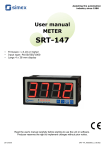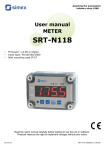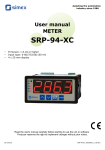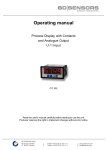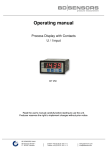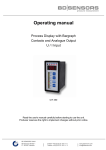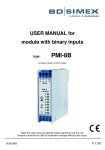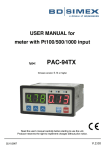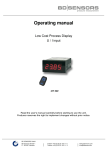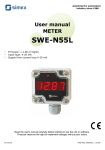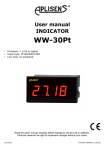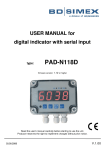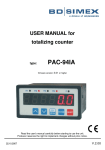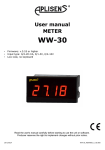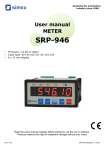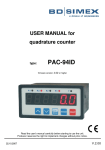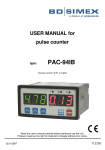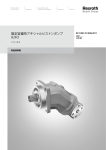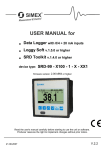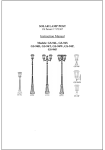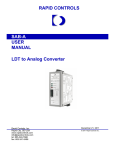Download English - BD Simex
Transcript
USER MANUAL for meter with thermocouple input type: PAC-94T firmware version: 5.16 or higher Read the user's manual carefully before starting to use the unit. Producer reserves the right to implement changes without prior notice. 10.12.2008 V.2.03 User manual for meter with thermocouple input PAC-94T CONTENTS 1. BASIC REQUIREMENTS AND USER SAFETY ....................................................................................... 3 2. GENERAL CHARACTERISTICS.............................................................................................................. 4 3. TECHNICAL DATA .................................................................................................................................. 4 4. DEVICE INSTALLATION ......................................................................................................................... 6 4.1. UNPACKING ................................................................................................................................. 6 4.2. ASSEMBLY ................................................................................................................................... 6 4.3. CONNECTION METHOD............................................................................................................... 8 4.4. MAINTENANCE ........................................................................................................................... 13 5. FRONT PANEL DESCRIPTION ............................................................................................................. 13 6. PRINCIPLE OF OPERATION ..................................................................................................................14 6.1. MEASUREMENT MODE.............................................................................................................. 14 6.2. DETECTION OF THE PEAK VALUES ..........................................................................................14 6.3. CONTROL OF THE RELAY OUTPUTS ........................................................................................15 6.3.1. One threshold mode ........................................................................................................... 17 6.3.2. Two thresholds mode.......................................................................................................... 18 7. DEVICE PROGRAMMING ...................................................................................................................... 19 7.1. PROGRAMMING MENU .............................................................................................................. 19 7.2. PARAMETERS EDITION ............................................................................................................. 20 7.2.1. Numeric parameters (digit change mode) ........................................................................... 20 7.2.2. Numeric parameters (slide change mode)........................................................................... 20 7.2.3. Switch parameters (“LIST” type) ......................................................................................... 21 7.3. MENU DESCRIPTION ................................................................................................................. 21 7.3.1. “rEL1” menu........................................................................................................................ 22 7.3.2. “bEEP” menu ...................................................................................................................... 24 7.3.3. “inPt” menu ......................................................................................................................... 24 7.3.4. “OutP” menu ....................................................................................................................... 25 7.3.5. “bri” parameter .....................................................................................................................26 7.3.6. “HOLd” menu ...................................................................................................................... 26 7.3.7. “SECu” menu ...................................................................................................................... 27 7.3.8. “rS” menu ........................................................................................................................... 27 7.3.9. “Edit” parameter .................................................................................................................. 28 7.3.10. “dEFS” parameter ............................................................................................................. 28 7.3.11. “SErv” menu ..................................................................................................................... 28 7.4. MENU STRUCTURE ................................................................................................................... 29 8. THE ALARM LED .................................................................................................................................. 31 9. CURRENT OUTPUT VALUE CALCULATION ....................................................................................... 31 10. THE MODBUS PROTOCOL HANDLING ............................................................................................. 31 10.1. LIST OF REGISTERS ................................................................................................................ 32 10.2. TRANSMISSION ERRORS DESCRIPTION ............................................................................... 36 10.3. EXAMPLES OF QUERY/ANSWER FRAMES ............................................................................ 36 11. DEFAULT AND USER'S SETTINGS LIST ............................................................................................39 2 User manual for meter with thermocouple input PAC-94T Explanation of symbols used in the manual: - This symbol denotes especially important guidelines concerning the installation and operation of the device. Not complying with the guidelines denoted by this symbol may cause an accident, damage or equipment destruction. IF THE DEVICE IS NOT USED ACCORDING TO THE MANUAL THE USER IS RESPONSIBLE FOR POSSIBLE DAMAGES. - This symbol denotes especially important characteristics of the unit. Read any information regarding this symbol carefully 1. BASIC REQUIREMENTS AND USER SAFETY - The manufacturer is not responsible for any damages caused by inappropriate installation, not maintaining the proper technical condition and using the unit against its destination. - Installation should be conducted by qualified personnel. During installation all available safety requirements should be considered. The fitter is responsible for executing the installation according to this manual, local safety and EMC regulations. - The unit must be properly set-up, according to the application. Incorrect configuration can cause defective operation, which can lead to unit damage or an accident. - If in the case of a defect of unit operation there is a risk of a serious threat to the safety of people or property additional, independent systems and solutions to prevent such a threat must be used. - The unit uses dangerous voltage that can cause a lethal accident. The unit must be switched off and disconnected from the power supply prior to starting installation of troubleshooting (in the case of malfunction). - Neighbouring and mating equipment must meet the requirements of appropriate standards and regulations concerning safety and be equipped with adequate antiovervoltage and anti-interference filters. - Do not attempt to disassemble, repair or modify the unit yourself. The unit has no user serviceable parts. Units, in which a defect was stated must be disconnected and submitted for repairs at an authorized service centre. - In order to minimize fire or electric shock hazard, the unit must be protected against atmospheric precipitation and excessive humidity. - Do not use the unit in areas threatened with excessive shocks, vibrations, dust, humidity, corrosive gasses and oils. 3 User manual for meter with thermocouple input PAC-94T - Do not use the unit in explosion hazard areas. - Do not use the unit in areas with significant temperature variations, exposed to condensation or icing. - Do not use the unit in areas exposed to direct sunlight. - Make sure that the ambient temperature (e.g. inside the control box) does not exceed the recommended values. In such cases forced cooling of the unit must be considered (e.g. by using a ventilator). The unit is designed for operation in an industrial environment and must not be used in a household environment or similar. 2. GENERAL CHARACTERISTICS The PAC-94T meter is equipped with thermocouple input (K, S, J, T, N, R, B, E). The measurement range depends on connected thermocouple type. Measurement is linearised by the polynomial characteristics referred to particular thermocouples and temperature of cold ends is compenssated automatically. The device has additional measurement range (-10 ÷ 90 mV) mainly for diagnostics of measurement circuits. Being in this range, unit displays direct voltage connected to its input (without compensation of cold ends). The result is presented on 4-digit LED display. For every thermocouples result is displayed as integer (no decimal point, e.g. 1460) and for mV range with 2 digits after decimal points (with resolution 0.01 mV e.g. -1.23). PAC-94T can be equipped with two or four relay (or OC type) outputs. Optionally with two relays outputs can be equipped with active current output. Device PAC-94T is equipped with RS-485 / Modbus RTU communication interface and 24 V/100 mA supply output for free use. The meter can be ordered in two power supply versions. 3. TECHNICAL DATA Power supply voltage (depending on version) External fuse (required) Power consumption 85...230...260 VAC/DC; 50 ÷ 60 Hz or 19...24...50 VDC; 16...24...35 VAC T - type, max. 2 A max. 4.5 VA @ 85 ÷ 260 VAC/DC max. 4.5 VA @ 16 V ÷ 35 VAC max. 4.5 W @ 19 V ÷ 50 VDC Measurement input thermocouple type: K, S, J, T, N, R, B, E Measurement range K: S: J: T: N: R: B: E: 4 -200 °C ÷ +1370 °C -50 °C ÷ +1768 °C -210 °C ÷ +1200 °C -200 °C ÷ +400 °C -200 °C ÷ +1300 °C -50 °C ÷ +1768 °C +250 °C ÷ +1820 °C -200 °C ÷ +1000 °C User manual for meter with thermocouple input PAC-94T Measurement accuracy ± 0.25 % ± one digit Accuracy of ends temperature compensation ÷ 1 °C Outputs relay: or OC-type: sensor power supply: active current: 0, 2 or 4 NO, 1 A/250 VAC (cos ϕ = 1) 0, 2 or 4, 30 mA / 30 VDC / 100 mW 24 V +5 %, -10 % / max. 100 mA, stabilized range max. 0 ÷ 24 mA, load resistance max.700 Ω (current output is optional, for two relays version only) Communication interface RS-485, 8N1 and 8N2, Modbus RTU, not separated Baud rate 1200 bit/sec ÷ 115200 bit/sec Display (depending on version) LED, 4 digit, 20 mm height, red or LED, 4 digit, 20 mm height, green Data memory non-volatile memory, EEPROM type Protection level IP 65 (from front, after using waterproof cover) IP 40 (from front) IP 20 (housing and connection clips) Housing type Housing material Housing dimensions Mounting hole Assembly depth Panel thickness panel NORYL - GFN2S E1 96 x 48 x 100 mm 90.5 x 43 mm min. 102 mm max. 5 mm Operating temperature Storage temperature 0 °C to +50 °C -10 °C to +70 °C Humidity Altitude 5 to 90 % no condensation up to 2000 meters above sea level Screws tightening max. torque 0.5 Nm Max. connection leads diameter 2.5 mm Safety requirements according to: PN-EN 61010-1 installation category: II pollution degree: 2 voltage in relation to ground: 300 VAC 2 insulation resistance: >20 MΩ insulation strength between power supply and input/output terminal: 1min. @ 2300 V insulation strength between relays terminal: 1min. @ 1350 V EMC according to: PN-EN 61326 5 User manual for meter with thermocouple input PAC-94T This is a class A unit. In housing or a similar area it can cause radio frequency interference. In such cases the user can be requested to use appropriate preventive measures. 4. DEVICE INSTALLATION The unit has been designed and manufactured in a way assuring a high level of user safety and resistance to interference occurring in a typical industrial environment. In order to take full advantage of these characteristics installation of the unit must be conducted correctly and according to the local regulations. - Read the basic safety requirements on page 3 prior to starting the installation. - Ensure that the power supply network voltage corresponds to the nominal voltage stated on the unit’s identification label. - The load must correspond to the requirements listed in the technical data. - All installation works must be conducted with a disconnected power supply. - Protecting the power supply clamps against unauthorized persons must be taken into consideration. 4.1. UNPACKING After removing the unit from the protective packaging, check for transportation damage. Any transportation damage must be immediately reported to the carrier. Also, write down the unit serial number on the housing and report the damage to the manufacturer. Attached with the unit please find: - user’s manual, - warranty, - assembly brackets - 2 pieces. 4.2. ASSEMBLY - The unit is designed for mounting indoor inside housings (control panel, switchboard) assuring appropriate protection against electric impulse waves. Metal housing must be connected to the grounding in a way complying with the governing regulations. - Disconnect the power supply prior to starting assembly. - Check the correctness of the performed connections prior to switching the unit on. In order to assembly the unit, a 90.5 mm x 43 mm mounting hole (Figure 4.1) must be prepared. The thickness of the material of which the panel is made must not exceed 5 mm. When preparing the mounting hole take the grooves for catches located on both sides of the housing into consideration (Figure 4.1). Place the unit in the mounting hole inserting it from the front side of the panel, and then fix it using the brackets (Figure 4.2). The minimum distances between assembly holes’ axes - due to the thermal and mechanical conditions of operation – are 115 mm x 67 mm (Figure 4.3). 6 User manual for meter with thermocouple input PAC-94T Figure 4.1. Mounting hole dimensions Figure 4.2. Installing of brackets, and dimensions of connectors. 7 User manual for meter with thermocouple input PAC-94T Figure 4.3. Minimum distances when assembly of a number of units 4.3. CONNECTION METHOD Caution - Installation should be conducted by qualified personnel. During installation all available safety requirements should be considered. The fitter is responsible for executing the installation according to this manual, local safety and EMC regulations. - The unit is not equipped with an internal fuse or power supply circuit breaker. Because of this an external time-delay cut-out fuse with minimal possible nominal current value must be used (recommended bipolar, max. 2 A) and a power supply circuit-breaker located near the unit. In the case of using a monopolar fuse it must be mounted on the phase cable (L). - The power supply network cable diameter must be selected in such a way that in the case of a short circuit of the cable from the side of the unit the cable shall be protected against destruction with an electrical installation fuse. - Wiring must meet appropriate standards and local regulations and laws. - In order to secure against accidental short circuit the connection cables must be terminated with appropriate insulated cable tips. - Tighten the clamping screws. The recommended tightening torque is 0.5 Nm. Loose screws can cause fire or defective operation. Over tightening can lead to damaging the connections inside the units and breaking the thread. - In the case of the unit being fitted with separable clamps they should be inserted into appropriate connectors in the unit, even if they are not used for any connections. - Unused clamps (marked as n.c.) must not be used for connecting any connecting cables (e.g. as bridges), because this can cause damage to the equipment or electric shock. 8 User manual for meter with thermocouple input PAC-94T If the unit is equipped with housing, covers and sealing packing, protecting against water intrusion, pay special attention to their correct tightening or clamping. In the case of any doubt consider using additional preventive measures (covers, roofing, seals, etc.). Carelessly executed assembly can increase the risk of electric shock. - - After the installation is completed do not touch the unit’s connections when it is switched on, because it carries the risk of electrical shock. Due to possible significant interference in industrial installations appropriate measures assuring correct operation of the unit must be applied. To avoid the unit of improper indications keep recommendations listed below. - Avoid common (parallel) leading of signal cables and transmission cables together with power supply cables and cables controlling induction loads (e.g. contactors). Such cables should cross at a right angle. - Contactor coils and induction loads should be equipped with anti-interference protection systems, e.g. RC-type. - Use of screened signal cables is recommended. Signal cable screens should be connected to the earthing only at one of the ends of the screened cable. - In the case of magnetically induced interference the use of twisted couples of signal cables (so-called “spirals”) is recommended. The spiral (best if shielded) must be used with RS-485 serial transmission connections. - In the case of interference from the power supply side the use of appropriate antiinterference filters is recommended. Bear in mind that the connection between the filter and the unit should be as short as possible and the metal housing of the filter must be connected to the earthing with largest possible surface. The cables connected to the filter output must not run in parallel with cables with interference (e.g. circuits controlling relays or contactors). Connections of power supply voltage and measurement signals are executed using the screw connections on the back of the unit’s housing. Figure 4.4. Method of cable insulation replacing and cable terminals 9 User manual for meter with thermocouple input PAC-94T All connections must be made while power supply is disconnected! Figure 4.5. Terminals description (relay outputs, no current output version) Figure 4.6. Terminals description (relay outputs, device with current output) Figure 4.7. Terminals description (OC-type outputs) 10 User manual for meter with thermocouple input PAC-94T Contacts of relay outputs are not equipped with spark suppressors. While use the relay outputs for switching of inductive loads (coils, contactors, power relays, electromagnets, motors etc.) it is required to use additional suppression circuit (typically capacitor 47 nF/min. 250 VAC in series with 100R/5 W resistor), connected in parallel to relay terminals or (better) directly on the load. In consequence of using the suppression circuit, the level of generated electromagnetic disturbances is lower, and the life of relay contacts rises. Figure 4.8. Examples of suppression circuit connection: a) to relay terminals; b) to the inductive load Depending on version: 85...230...260 VAC/DC or 19...24...50 VDC; 16...24...35 VAC Figure 4.9. Connection of power supply and relays 11 User manual for meter with thermocouple input PAC-94T Figure 4.10. Example of OC-type outputs connection Figure 4.11. Example of current outputs connection (for device with current output only) 12 User manual for meter with thermocouple input PAC-94T 4.4. MAINTENANCE The unit does not have any internal replaceable or adjustable components available to the user. Pay attention to the ambient temperature in the room where the unit is operating. Excessively high temperatures cause faster ageing of the internal components and shorten the fault-free time of unit operation. In cases where the unit gets dirty do not clean with solvents. For cleaning use warm water with small amount of detergent or in the case of more significant contamination ethyl or isopropyl alcohol. Using any other agents can cause permanent damage to the housing. Product marked with this symbol should not be placed in municipal waste. Please check local regulations for disposal and electronic products. 5. FRONT PANEL DESCRIPTION Symbols and functions of push-buttons: Symbol used in the manual: [ESC/MENU] Functions: • Enter to main menu (press and hold by at least 2 sec.) • Exit the current level and Enter to previous menu (or measure mode) • Cancel the changes made in parameter being edited Symbol used in the manual: [ENTER] Functions: • Start to edit the parameter • Enter to the sub-menu • Confirmation of changes made in parameter being edited Symbol used in the manual: [^] [v] Functions: • Change of the present menu, • Modification of the parameter value, • Change of the display mode. 13 User manual for meter with thermocouple input PAC-94T 6. PRINCIPLE OF OPERATION After turning the power supply on, device ID and software version are showed on the display, next the controller goes to the measurement mode. 6.1. MEASUREMENT MODE In the measure mode the measurement results, are displayed on the display. If the result of measurement exceeds the permissible measurement range, warning “-Hi-“ or “-Lo-“ is displayed rather than calculated result, depends on exceeded value. In the measurement mode user can check main thresholds values. After pressing [^] or [v] button, name of the threshold (e.g. “rEL1”) and his value will be displayed on the display in alternating mode. If [^] or [v] will be pressed in 5 sec again, the next threshold will be displayed, else the device comes back to the measurement mode. If a free access is enabled (see description of “SECu” menu), user can change the value of particular threshold pressing button [ENTER] (see: PARAMETERS EDITION). All accessible parameters can be changed by entering the menu (see: DEVICE PROGRAMMING). Use the local keyboard or the remote controller to do it. (Note: all parameters can be remote changed via RS-485 interface). Configuration of the device (via menu or RS-485 interface) do not stops measures. 6.2. DETECTION OF THE PEAK VALUES The PAC-94T controller is equipped with peaks detection function. It can detect a peaks of the input signal and display their values. Presets connected with this function are placed in “HOLd” menu (see description of “HOLd” menu). The detection of the peak can be done if the measured signal raises and drops of value at least equal to parameter “PEA”. Detected peaks are displayed during the time defined by parameter “timE”. If a new peak will be detected while one is displayed, this new peak will be displayed and display time counter will be cleared (Figure 6.1). If no peaks are detected while time “timE” elapses, device starts to show the current value of input signal again. The relays/LEDs can be controlled depend on the current value of input signal or the peak value (see “HOLd” menu). 14 User manual for meter with thermocouple input PAC-94T Figure 6.1. Process of peaks detection 6.3. CONTROL OF THE RELAY OUTPUTS The control of the object (measured signal) is realized via relay outputs. Front panel LEDs named “R” indicates the state of particular relay output. If device is not equipped with one or more relay outputs, menus refer to this relays are available, but apply to LED indicators only. In such case LEDs indicates exceeding of particular thresholds. Modes of the control can be changed depend on the values of parameters “SEtP”, “SEt2”, “HYSt”, “modE”, “t on”, “toFF”, “unit” and “AL”. Depend on “modE” parameter, relays can be not used or controlled over one or two thresholds values. If one threshold is used (Figure 6.2) the relay can be turned on (“modE” = “on”) or off (“modE” = “oFF”) when the input signal value is contained in zone A. If two thresholds are used (Figure 6.3) the relay will be turned on when value of input signal is contained in zone A (“modE” = “in”) or zone B (“modE” = “out”) and turned off if the signal is contained in the second one. 15 User manual for meter with thermocouple input PAC-94T Figure 6.2. One threshold control of the relay/LED outputs Figure 6.3. Two thresholds control of the relay/LED outputs The relay outputs and LEDs (named R) can be controlled depend on both - the current value and the peak value (when peak detection is active) of the input signal. 16 User manual for meter with thermocouple input PAC-94T 6.3.1. One threshold mode Figure 6.4 presents the principle of relay outputs operation for one threshold mode, and an example values of other parameters. Description: A, B, C, D BON, BOFF, DON, DOFF tA, tB, tC, tD - points where measured signal exceeds border values (expected value ± allowed deviation) - relays state changes moments: (for “t on” > 0, “toFF” > 0) - time periods while input signal is in zone A or zone B Figure 6.4. Principle of LED/relay output operation for one threshold mode Parameter “SEtP” sets a threshold of the relay, and parameter “HYSt” sets a hysteresis of the relay (Figure 6.4 a). The relay can change his state only when input value exceeds (over or under) border value and tA, tB, tC, tD times (Figure 6.4) are bigger than the time defined by parameters “t on”, “toFF” and “unit”. Border values means values equal threshold+hysteresis and threshold-hysteresis respectively. If “t on” and “toFF” parameters are set to “0”, then the relay state will be changed as soon as input value exceeds any of the border values (see points A and C, Figure 6.4 a, b, c). If values of “t on” or/and “toFF” are positive, then relay state will be turned on if the input value exceeds the border values and stay bigger (or lower) during at least “t on” (see points BON, DON, Figure 6.4 a, d, e). Similarly, the relay will be turned off if time “toFF” elapse since the input signal value exceeds any of the border values (see points BOFF, DOFF, Figure 6.4 a, d, e). 17 User manual for meter with thermocouple input PAC-94T If tA ,tB ,tC or tD (when input signal stay in zone A or zone B) are lower than parameters “t on” or “toFF”, the relay will not change his state (see points A and C, Figure 6.4 a, d, e). The state of relay output while the input value exceeds the border values (points A, B, C, D) is described by parameter “modE”. The relay can be turned on (“modE” = “on”), or turned off (“modE” = “oFF”) when input signal value is contained in zone A (Figure 6.4 a). The parameter “AL” allow user to set the relay output behaviour in critical situations (e.g. Input values exceeds permissible measurement range). User can select that the relays will be turned on, turned off, or not changed in critical situations. All parameters connected with relay outputs are described in paragraph “rEL1” menu. 6.3.2. Two thresholds mode Description: A, B, C, D, E BON, BOFF, CON, COFF , EON, EOFF tA, tB, tC, tD, tE - points where measured signal exceeds border values (expected value ± allowed deviation) - relays state changes moments: (for “t on” > 0, “toFF” > 0) - time periods while input signal is in zone A or zone B Figure 6.5. Principle of LED/relay output operation for two thresholds mode 18 User manual for meter with thermocouple input PAC-94T Figure 6.5 presents the principle of relay outputs operation for two thresholds mode, and an example values of other parameters. In this mode parameter “SEt2” is accessible in common with “SEtP”, this parameter describes a second threshold of the relay output. The parameters “HYSt”, “modE”, “t on”, “toFF”, “unit” and “AL” are connected with both “SEtP” and “SEt2” thresholds. While the controlling process, the relay output changes his state depends of both “SEtP” and “SEt2” thresholds in similar way as it was described in one threshold mode. If two threshold mode is used, “modE” parameter defines state of the relay output when the input value occurs in a particular zone defined by border values of both thresholds. The relay can be turned on if the input value is contained in zone A (“modE” = “in”) or zone B (“modE” = “out”) and turned off if it is contained in the second one (Figure 6.5). The sequence of thresholds “SEtP” and “SEt2” can be set in any order, due to the control of relay outputs is done depend on difference between thresholds values (zone A ) and outside of threshold values (zone B). 7. DEVICE PROGRAMMING The device menu allow user to set all parameters connected to operation of measurement input, control modes, critical situations behaviour, communication via RS-485 and access settings. The meaning of the particular parameters is described in paragraph MENU DESCRIPTION. Some of the parameters can be accessed without menu entering (quick view mode). After pressing [^] or [v] button, name of the threshold (e.g.”rEL1”) and his value will be displayed on the display in alternating mode. If [^] or [v] will be pressed in 5 sec again, the next threshold will be displayed, else the device comes back to the measurement mode. If a free access is enabled (see description of “SECu” menu), user can change the value of particular threshold pressing button [ENTER] (see: PARAMETERS EDITION). If particular parameter has been changed and confirmed in quick view mode, its new value is displayed in alternating mode with parameter name by few seconds. Confirmed changes may be checked or user can switch viewed parameter pressing [^] or [v] button. 7.1. PROGRAMMING MENU To enter main menu (being in the measurement mode) operator must to press and hold at least 2 sec. [ESC/MENU] button. If the user password is defined (see parameter “Scod“, menu “SECU”), operator have to enter correct one before proceeding to menu options. Entering of the passwords is similar to the edition of numeric parameters (see: PARAMETERS EDITION), however presently editing digit is showed only on the display, other digits are replaced by “-” sign. After entering of last digit of the password first menu position will be displayed (if the password is correct) or warning “Err” in other case. Pay attention when device parameters are being changed. If it is possible, turn off controlled installation (machine). 19 User manual for meter with thermocouple input PAC-94T Functions of the buttons while sub-menu and parameters choice: Selection of sub-menu or parameter for editing. Name of selected item (sub-menu or parameter) is displayed. Operation of [ENTER] button depend on present menu position: • if the name of some sub-menu is displayed - enter this sub-menu; name of the first parameter (or next level sub-menu) is displayed. • if the name of some parameter is displayed - enter the edition of this parameter; present value of the parameter is displayed. [ESC/MENU] button allow user to exit present menu level and goes to upper level menu (or measurement mode). After about 1 min. since last use of the buttons, device exits the menu mode and returns to the measurement mode (only if no parameters are in editing mode). 7.2. PARAMETERS EDITION To start edition of any parameter user should select name of desired one using [^] [v] buttons and then press [ENTER]. 7.2.1. Numeric parameters (digit change mode) Numerical parameters are displayed as decimal numbers. The mode of its new value entering depends on chosen edit method (see parameter “Edit”). In mode “by digit” (“Edit”=”dig”) pressing one of the keys [^] or [v] causes change of current position (flashing digit) or the sign (+/-). Short pressing of the [ENTER] button causes change of the position (digit). Press [ENTER] at least 2 seconds to accept the changes, after that question “SEt?” is displayed, and user must to confirm (or cancel) the changes. To conform changes (and story it in EEPROM) press [ENTER] button shortly after “SEt?” is displayed. To cancel the changes press [ESC] button shortly after “SEt?” is displayed. After that device returns to the menu. 7.2.2. Numeric parameters (slide change mode) In “slide change” mode (“Edit”=”Slid”), buttons [^] and [v] has different functions. To increase edited value press (or press and hold) [^] button only, the increasing became quickest as long as button [^] is pressed. To slow down the increasing, button [v] can be used. If [v] is pressed shortly (and button [^] is still pressed), increasing slow down for a moment only, if [v] is pressed and held while button [^] is still pressed the increasing slow down and will be kept on lower speed. To decrease edited value press (or press and hold) [v] button only. The decreasing became quickest as long as button [v] is pressed. To slow down the decreasing, button [^] can be used. If [^] is pressed shortly (and button [v] is still pressed), decreasing slow down for a moment only, if [^] is pressed and held while button [v] is still pressed the decreasing slow down and will be kept on lower speed. 20 User manual for meter with thermocouple input PAC-94T Press [ENTER] at least 2 seconds to accept the changes, after that question “Set?” is displayed, and user must to confirm (or cancel) the changes. To conform changes (and story it in EEPROM) press [ENTER] button shortly after “SEt?” is displayed. To cancel the changes press [ESC] button shortly after “SEt?” is displayed. After that device returns to the menu. 7.2.3. Switch parameters (“LIST” type) Switch parameters can be described as a sets of values (a lists) out of which only one of the options available on the list can be selected for the given parameter. Options of switching parameter are selected using [^], [v] keys. Short pressing of [ENTER] causes in displaying of the acknowledge question (“SEt?”). If key [ENTER] is pressed again, the changes are accepted, stored in EEPROM end the edition process finished. Pressing the key [ESC] after “SEt?” causes in cancelling of made changes and returning to menu. Functions of buttons when editing numeric and switching parameters: While editing numeric parameter: • change of current (flashing) digit • slide change of value (acceleration, deceleration, direction change) While editing switch parameter - selection of switch parameter. If numerical parameter is being edited, a short press of [ENTER] button change edited position. A long press of [ENTER] button (at lest 2 sec.) causes of display a “SEt?” ask, which allow user to make sure if change of the parameter value is correct. If switch parameter is being edited, a short press of [ENTER] button causes of display a “SEt?” ask. When [ENTER] button is pressed again (while “SEt?” is displayed) the new value of the parameter is stored in EEPROM memory. Pressing this button operator can cancel the changes done up to now (if they were not approved by [ENTER] button after the “SEt?” ask) and come back to menu 7.3. MENU DESCRIPTION “- - - -” - password checking. If some password different from “0000” is set, then every enter to main menu follows the entering of password. If entered password is correct then first menu position will be displayed else warning “Err”, and unit returns to measurement mode. Due to problem with direct displaying of “m” and “K” letters, they are exchanged with special signs “ “ for “m” and “ “ for “K” respectively. However, in user manual letters “m” and “K” are used to make it more readable (example: “modE”, “tc K”). 21 User manual for meter with thermocouple input PAC-94T 7.3.1. “rEL1” menu This menu allows to configure the operation mode of relays and LEDs marked “R” (e.g. “R1”). If there are few relay outputs available, then every output has its own configuration menu (e.g. menu “rEL2” for relay (LED) “R2”). Principle of the relays operation is described in paragraph CONTROL OF THE RELAY OUTPUTS . • • The relay outputs and LEDs (named R) can be controlled depend on both - the current value and the peak value (when peak detection is active) of the input signal. If device is not equipped with one or more relay outputs, menus refer to this relays are available, but apply to LED indicators only. In such case LEDs indicates exceeding of particular thresholds. “SEtP” - first threshold of the relay (range -999 ÷ 9999). Negative values can be input by selecting a “-” sign on first digit (to change value use [^] and [v] buttons). Threshold is the medium value of relay hysteresis. “SEt2” - second threshold of the relay (range -999 ÷ 9999). Negative values can be input by selecting a “-” sign on first digit (to change value use [^] and [v] buttons). This threshold is accessible when “modE” parameter is set to “in” or “out” value. Threshold is the medium value of relay hysteresis. “HYSt” - hysteresis of relay (range 0 ÷ 999). Full hysteresis of the relay is equal to 2x “HYSt” parameter. The relay state can change when an input signal is out of threshold-hysteresis to threshold+hysteresis zone. Presented parameters should be set to ensure that “SEtP” + “HYSt”, “SEt2” + “HYSt”, “SEtP” – “HYSt” or “SEt2” – “HYSt” do not exceeds the measure range. Additionally, in two threshold mode (“modE”= “in” or “out”), the hysteresis for both thresholds must not cover each other (in other case relay can't change his state). “modE” - relay operation mode: “noAC” - the relay is not active (permanent turned off) “on” -one threshold mode, the relay is turned ON when input signal exceeds SEtP + HYSt value, and is turned off back when the input signal became lower than SEtP – HYSt, 22 “oFF” - one threshold mode, the relay is turned OFF when input signal exceeds SEtP + HYSt value, and is turned on back when the input signal became lower than SEtP – HYSt, “in” - two thresholds mode, the relay is turned ON when the input signal is bigger than “lower threshold + HYSt” and lower than “bigger threshold – HYSt”, and turned off when the input signal is contained in the second zone. The bigger threshold means bigger one of “SEtP” and “SEt2” thresholds, the lower threshold means lower one of “SEtP” and “SEt2” thresholds. User manual for meter with thermocouple input PAC-94T “out” - two thresholds mode, relay is turned ON when the input value is bigger than “bigger threshold + HYSt” and lower than “lower threshold – HYSt”, and turned on when the input signal is contained in the second zone. The bigger threshold means bigger one of “SEtP” and “SEt2” thresholds, the lower threshold means lower one of “SEtP” and “SEt2” thresholds. “modb” - the relay is controlled via RS-485 interface, independently on the input signal. • • LEDs light when relays are closed, independently of relays' mode. When power supply fail, unit do not store relays state selected by RS-485 interface. “t on” - turn on delay time, the relay is turned on with delay equal “t on” if the input value exceeds appropriate border value (defined with threshold and hysteresis), at least “t on” time. “t on” range 0 ÷ 99.9, defined with 0.1 sec. resolution. Unit of this parameter is set by “unit” parameter. “toFF” - turn off delay time, the relay is turned off with delay equal “toFF” if the input value exceeds appropriate border value (defined with threshold and hysteresis), at least “toFF” time. “toFF” range 0 ÷ 99.9, defined with 0.1 sec. resolution. Unit of this parameter is set by “unit” parameter. If time when the input signal exceeds some border value is shorter than “t on” or “toFF” time, the relay do not change his state (see paragraph: CONTROL OF THE RELAY OUTPUTS). “unit” - unit of time for “t on” i “toFF” parameters. Can be set on one of two values: “min” “SEC” “AL” - minutes, - seconds. - this parameter defines the relay reaction when some critical situations occurs: “noCH” - relay do not change his state, “on” - relay will be turned on, “oFF” - relay will be turned off. If parameter “modE” is set to “on”, “oFF”, “in” or “Out” the “critical situation” means that allowable measurement range is exceeded. If parameter “modE” is set to “modb”, the “critical situation” means communication delay (when no data is received) longer than “mbtO” parameter (see description: “rS” menu). • If option “noCH” is selected for “AL” parameter, behaviour of the relay may depend on “FiLt” parameter in some cases. If “FiLt” is set to big value and the input signal drops, result value of the measure will change slow, causes of turning on or off relay due to thresholds values. The critical situation is slowly detected, so it is impossible to predict the relay state in that situations. • If parameter “AL” = “on”, the relay will be turned on in the critical situations, even if his parameter “modE” = “noAC” 23 User manual for meter with thermocouple input PAC-94T 7.3.2. “bEEP” menu This menu contains options connected with acoustic signal: “AL” “r1” “r2” “r3” “r4” - if this parameter is set to “on”, any critical situation causes by acoustic signal - if this parameter is set to “on”, activation of relay R1 causes by acoustic signal - if this parameter is set to “on”, activation of relay R2 causes by acoustic signal - if this parameter is set to “on”, activation of relay R3 causes by acoustic signal - if this parameter is set to “on”, activation of relay R4 causes by acoustic signal Acoustic signal (turned on by e.g. relay) can be turned off by pressing of any button 7.3.3. “inPt” menu This menu presets the measurement input: “tYPE” - type of the input / sensor. This parameter can be set to values: thermocouple type measurement range “tc K” -200 ˚C ÷ +1370 ˚C “tc S” -50 ˚C ÷ +1768 ˚C “tc J” -210 ˚C ÷ +1200 ˚C “tc t” -200 ˚C ÷ +400 ˚C “tc n” -200 ˚C ÷ +1300 ˚C “tc r” -50 ˚C ÷ +1768 ˚C “tc b” +250 ˚C ÷ +1820 ˚C “tc E” “volt” -200 ˚C ÷ +1000 ˚C The device has additional measurement range (-10 ÷ 90 mV) mainly for diagnostics of measurement circuits. Being in this range, unit displays direct voltage connected to its input with resolution 0.01 mV (without compensation of cold ends). “FiLt” - this parameter sets filtration rate. It can be set to values from 0 (no filtration) to 5 (strongest filtration – time window about 2 sec). “toFS” - offset (expressed in 1 °C, range ± 9.9 °C.). This parameter allows shifting of measurement scale, and express value added to calculated (measured) result. Warning: The offseting of a scale is realised independently of cold ends automatic compensation. 24 User manual for meter with thermocouple input PAC-94T 7.3.4. “OutP” menu This menu contains parameters of current output control. Menu is available if the device is equipped witch current output. Current output can be controlled depend on both present measured value and peak value (if peak detection is enabled). “Omod” - current output mode, can be set to values: “oFF” “0-20” “4-20” “modb” ” - current output disabled, - current output enabled with 0 ÷ 20 mA mode, - current output enabled with 4 ÷ 20 mA mode, - current output controlled via RS-485 interface. “OUtL” - this parameter determines the input value for which the output current is minimal (0 mA or 4 mA depend of current output mode “Omod”). “OUtH” - this parameter determines the input value for which the output current is equal 20 mA. The output current value is calculated due to formulas given below: where “W” denotes the displayed value. “OutL” parameter can be greater than “OutH”. In this case the conversion characteristic is reversed, it means that if input value raises the output current falls. “Lo r”, “Hi r” - this parameters define the output current range (maximum range 0 to 24 mA). If calculated output value Iout exceeds defined range then current output generates the current equal to upper or lower border of the defined range. The parameters define the percentage extension of nominal current range 4-20 mA (with 0.1 % resolution). Parameter “Lo r” defines lower border of the range due to formula: Imin = 4 mA - 4 mA × “Lo r” %. This parameter can be set from 0 to 99.9 %. 25 User manual for meter with thermocouple input PAC-94T Parameter “Hi r” defines lower border of the range due to formula: Imax = 20 mA + 20 mA × “Hi r” %. This parameter can be set from 0 to 19.9 %. In example on page 31 of the DISPLAY VALUES CALCULATION paragraph the procedure of the current outputs determining is presented in details. “AL” - this parameter determines the behaviour of current output if any critical situation occurs. The parameter can be set to one of the values: “noCH” “22.1” “3.4” “0.0” - current will not change, - current will be set to 22.1 mA, - current will be set to 3.4 mA, - current will be set to 0 mA. When the critical situation goes, the current will be set to value calculated due to formulas given above. 7.3.5. “bri” parameter This parameter allows user to set bright of the LED display, bright can be set to conventional values from 1 to 8. 7.3.6. “HOLd” menu This menu contains parameters connected with peak detection function. See also full description of the peak detection function in paragraph: DETECTION OF THE PEAK VALUES “modE” - the type of detected changes of the input signal, can be set to values: “norm” “inv” - peaks, peak and next drop of the input signal of value equal at least “PEA”, - drops, drop and next peak of the input signal of value equal at least “PEA”, “PEA” - minimal detected signal change classified as peak or drop (see Figure 6.1) “timE” - maximum time of displaying of the peak (drop) value, can be set from 0.1 to 19.9 sec, with 0.1 sec. resolution “HdiS” - type of displayed values: “rEAL” “HOLd” - current value is displayed, - peak (drop) value is displayed, “H r1” ÷, - relay/LED outputs (R1 ÷ R4) operation mode: “H r4” “rEAL” - relay/LED operates depend on the current value, “HOLd” - relay/LED operates depend on the peak (drop) value. 26 User manual for meter with thermocouple input PAC-94T “HOUt” - current output operation mode: “rEAL” “HOLd” - current output operates depend on the current value, - current output operates depend on the peak (drop) value. 7.3.7. “SECu” menu This menu contains presets connected with availability of other parameters: “Scod” - user password (4-digits number). If this parameter is set at value “0000”, user password is turned off. If the user do not remember his password, the access to the menu is possible by the “one-use password”. To get this password please contact with Marketing Division. “Single use password” can be used only one time, after that it is destroyed. Entering this password causes in clearing of user password, it means sets the user password to “0000”. The “one-use password” can be used ONE TIME ONLY, it is impossible to use it again! The “one-use password” can be restored by Service Division only. “A r1” ÷, - this option permits user (“on”) or prohibits (“oFF”) to modify the thresholds of the “A r4” relays/LEDs R1 ÷ R4 without knowledge about user password. 7.3.8. “rS” menu This menu is connected with RS-485 interface, and sets his properties: “Addr” - this parameter defines the address of the device, accordingly to Modbus protocol. It can be set in range from 0 to 199. If the value 0 is set then device, responds to frames with address 255 (FFh). “bAud” - this parameter determines RS-485 interface baud rate. It can be set to one of 8 possible values: “1.2”, “2.4”, “4.8”, “9.6”, “19.2”, “38.4”, “57.6”, “115.2”, which respond to the baud rates of 1200, 2400, 4800, 9600, 19200, 38400, 57600 and 115200 bit/sec respectively. “mbAc” - this parameter sets the access to the configuration registers of the device. Possible values: “on” - configuration registers can be set via RS-485 interface, “oFF” - configuration registers cannot be set via RS-485 interface. The access to registers no 04h i 05h can’t be denied by “mbAc” parameter (see: LIST OF REGISTERS). “mbtO” - this parameter defines maximal time (sec) between following frames received by the device. If the delay will be greater than the value of “mbtO” parameter, the relays which are controlled via RS-485 interface, will set to alert state (see “rEL1” menu description). Parameter “mbtO” can be set to values from 0 to 99 seconds. The value 0 means that the time will be not controlled. 27 User manual for meter with thermocouple input PAC-94T “rESP” - this parameter defines minimal (additional) delay between the Modbus message and the answer of the device (received and sent via RS-485 interface). This additional delay allows the device to work with poor RS-converters which do not works properly on baud rates higher than 19200. This parameter can be set to one of values: “Std” “10c” “20c” “50c” “100c” “200c” - answer as quick as possible, no additional delay - answer delayed of 10, 20, 50, 100 of 200 chars respectively, whereone character time depends on selected baud rate In the most cases parameter “rESP” should be set to “Std” (no additional delay). Unfortunately for some third party RS-converters “rESP” should be adjusted experimentally. Table 7.1 contains most frequently used values. “bAud” parameter “38.4” “57.6” “115.2” “rESP” parameter “10c” “20c” “50c” Tab.7.1. Settings of “rESP” parameter 7.3.9. “Edit” parameter This parameter allows to change the edition mode of numerical parameters: “dig” - the change to “by digit” mode, “Slid” - slide change mode. 7.3.10. “dEFS” parameter This setting allows to restore the factory settings of the device. To get the access to this option special password is required: “5465”, next the device displays acknowledge question “SEt?”. Press [ENTER] to acknowledge the restoring of factory settings or [ESC] to cancel. 7.3.11. “SErv” menu This menu contains the parameters for authorized service only. To enter this menu proper service password must be entered. Improper settings can causes of damage of the device. 28 User manual for meter with thermocouple input PAC-94T 7.4. MENU STRUCTURE 29 User manual for meter with thermocouple input PAC-94T 30 User manual for meter with thermocouple input PAC-94T 8. THE ALARM LED Alarm LED (AL) lights in cases: • exceeding of permissible measurement range • detection of sensor malfunction (shortcut or break of measurement circuit) 9. CURRENT OUTPUT VALUE CALCULATION Let the current output parameters be: “modE” = “on”, “OUtL” = 100, “OUtH” = 200, “Lo r” = 5.0, “Hi r” = 5.0 Parameters “Lo r” and “Hi r” define working range of current output to 3.8 ÷ 21 mA. Output current will be calculated for three displayed values “D”: a) D = “17.5” According to formula from page 25: Iout = (17.5-10.0) / (20.0-10.0) × 16 mA + 4 mA = 0.75 × 16 + 4 = 16 mA Calculated Iout do not exceeds the output working range (3 - 21 mA). b) D = “20.5” According to formula from page 25: Iout = (20.5-10.0) / (20.0-10.0) × 16 mA + 4 mA = 1.05 × 16 + 4 = 20.08 mA Calculated Iout do not exceeds the output working range (3 - 21 mA). c) D = “30.0” According to formula from page 25: Iout = (30.0-10.0) / (20.0-10.0) × 16 mA + 4 mA = 2 × 16 + 4 = 36 mA. Calculated Iout exceeds the output working range (3 - 21 mA), so current output will generate current equal to the upper border of range defined by parameter “Lo r” i “Hi r” (it means 21 mA). 10. THE MODBUS PROTOCOL HANDLING Transmission parameters: 1 start bit, 8 data bits, 1 or 2 stop bit (2 bits are send, 1 and 2 bits are accepted when receive), no parity control Baud rate: selectable from: 1200 to 115200 bits/sec Transmission protocol: MODBUS RTU compatible The device parameters and display value are available via RS-485 interface, as HOLDING-type registers (numeric values are given in U2 code) of Modbus RTU protocol. The registers (or groups of the registers) can be read by 03h function, and wrote by 06h (single registers) or 10h (group of the registers) accordingly to Modbus RTU specification. Maximum group size for 03h and 10h functions cannot exceeds 16 registers (for single frame). The device interprets the broadcast messages, but then do not sends the answers. 31 User manual for meter with thermocouple input PAC-94T 10.1. LIST OF REGISTERS Register Write 32 Range 01h No see measurement range 02h No 0h, A0h, 60h 03h No 0 or 2 04h Yes see descr. 05h1 Yes 0h ÷ 1800h 06h No 08h No see measurement range 0 ÷ 50 Register description Measurement value (no decimal point) The status of the current measurement; 0h - data valid; A0h - top border of the measurement range is exceeded; 60h - bottom border of the measurement range is exceeded; Decimal point position, constant value: 0 (without decimal point) - for thermocouple ranges 2 ( two digits after decimal point) - for diagnostic range State of the relays and alarm LED (binary format) (1 - on, 0 - off): 00000000 000edcba a - relay R1; b - relay R2; c - relay R3; d - relay R2; e - alarm LED; If written, only a, b, c, d bits are important (others are ignored) these bits allows user to control the relays via RS-485 interface State of current output, expressed in 1/256 mA units – it means that high byte express integer part, and low byte fractional part of desired output current. Peak (drop) value (no decimal point) Temperature inside device housing expressed by 1 °C 10h Yes 0÷8 “tyPE” parameter in “InPt” menu (input type). 0 - thermocouple input K; 1 - thermocouple input S; 2 - thermocouple input J; 3 - thermocouple input T; 4 - thermocouple input N; 5 - thermocouple input R; 6 - thermocouple input B; 7 - thermocouple input E; 8 - diagnostic voltage range 12h Yes 0÷5 “FiLt” parameter in “InPt” menu (measurement filtering rate) 18h Yes -99 ÷ 99 “toFS” parameter in “InPt” menu (shift of measurement scale), expressed by 0.1 °C 20h2 Yes 0 ÷ 199 Device address 21h No 20B8h Device identification code (ID) 3 22h Yes 0÷7 “bAud” parameter in “rS” menu (baud rate); 0 - 1200 baud; 1 - 2400 baud; 2 - 4800 baud; 3 - 9600 baud; 4 - 19200 baud; 5 - 38400 baud; 6 - 57600 baud; 7 - 115200 baud 23h4 Yes 0÷1 “mbAc” parameter in “rS” menu (permission to write registers via RS-485 interface); 0 - write denied ; 1 - write allowed 24h Yes see descr. Parameters of “SECU” menu (binary format (0 – “oFF”, 1 – “on”)): bit 0 - “A r1” parameter; bit 1 - “A r2” parameter bit 2 - “A r3” parameter; bit 3 - “A r4” parameter User manual for meter with thermocouple input PAC-94T Register Write Range Register description 25h Yes 0÷5 “rESP” parameter in “rS” menu (additional response delay); 0 - no additional delay; 1 - ”10c” option; 2 - ”20c” option; 3 - ”50c” option; 4 - ”100c” option; 5 - ”200c” option; 27h Yes 0 ÷ 99 “mbtO” parameter in “rS” menu (maximum delay between received frames); 0 - no delay checking; 1 ÷ 99 - maximum delay expressed in seconds 28h Yes 0÷1 “AL” parameter in “bEEP” menu: 0 - off; 1 - on 29h Yes 0÷1 “R1” parameter in “bEEP” menu: 0 - off; 1 - on 2Ah Yes 0÷1 “R2” parameter in “bEEP” menu: 0 - off; 1 - on 2Bh Yes 0÷1 “R3” parameter in “bEEP” menu: 0 - off; 1 - on 2Ch Yes 0÷1 “R4” parameter in “bEEP” menu: 0 - off; 1 - on 2Dh Yes 1÷8 “bri” parameter (display brightness); 1 - the lowest brightness; 8 - the highest brightness 2Fh Yes 0÷1 “Edit” parameter (numerical parameters edit mode); 0 - „dig” mode; 1 - „SLid” mode 30h Yes -999 ÷ 9999 “SEtP” parameter in “rEL1” menu, no decimal point included 31h Yes -999 ÷ 999 “HySt” parameter in “rEL1” menu, no decimal point included 32h Yes 0÷3 33h Yes 0 ÷ 999 “t on” parameter in “rEL1” menu, expressed in tenth of seconds or tenth of minutes depend on “unit” parameter - register no. 35h) 34h Yes 0 ÷ 999 “toFF” parameter in “rEL1” menu, expressed in tenth of seconds or tenth of minutes depend on “unit” parameter - register no. 35h) 35h Yes 0÷1 “unit” parameter in “rEL1” menu: 0 - seconds; 1 - minutes 36h Yes 0÷2 “AL” parameter in “rEL1” menu: 0 - no changes; 1 - on; 2 - off 37h Yes -999 ÷ 9999 “SEt2” parameter in “rEL2” menu, no decimal point included 38h Yes -999 ÷ 9999 “SEtP” parameter in “rEL2” menu, no decimal point included 39h Yes -999 ÷ 999 “HySt” parameter in “rEL2” menu, no decimal point included 3Ah Yes 0÷3 3Bh Yes 0 ÷ 999 “modE” parameter in “rEL1” menu: 0 - “noAC” mode; 1 - “on” mode; 2 - “oFF” mode; 3 - “in” mode; 4 - “out” mode; 5 - “modb” mode “modE” parameter in “rEL2” menu: 0 - “noAC” mode; 1 - “on” mode; 2 - “oFF” mode; 3 - “in” mode; 4 - “out” mode; 5 - “modb” mode “t on” parameter in “rEL2” menu, expressed in tenth of seconds or tenth of minutes depend on “unit” parameter - register no. 3Dh) 33 User manual for meter with thermocouple input PAC-94T Register Write 3Ch Yes Range 0 ÷ 999 Register description “toFF” parameter in “rEL2” menu, expressed in tenth of seconds or tenth of minutes depend on “unit” parameter - register no. 3Dh) 3Dh Yes 0÷1 “unit” parameter in “rEL2” menu: 0 - seconds; 1 - minutes 3Eh Yes 0÷2 “AL” parameter in “rEL2” menu: 0 - no changes; 1 - on; 2 - off 3Fh Yes -999 ÷ 9999 “SEt2” parameter in “rEL2” menu, no decimal point included 40h Yes -999 ÷ 9999 “SEtP” parameter in “rEL3” menu, no decimal point included 41h Yes -999 ÷ 999 “HySt” parameter in “rEL3” menu, no decimal point included 42h Yes 0÷3 43h Yes 0 ÷ 999 “modE” parameter in “rEL3” menu: 0 - “noAC” mode; 1 - “on” mode; 2 - “oFF” mode; 3 - “in” mode; 4 - “out” mode; 5 - “modb” mode “t on” parameter in “rEL3” menu, expressed in tenth of seconds or tenth of minutes depend on “unit” parameter - register no. 45h) 44h Yes 0 ÷ 999 “toFF” parameter in “rEL3” menu, expressed in tenth of seconds or tenth of minutes depend on “unit” parameter - register no. 45h) 45h Yes 0÷1 “unit” parameter in “rEL3” menu: 0 - seconds; 1 - minutes 46h Yes 0÷2 “AL” parameter in “rEL3” menu: 0 - no changes; 1 - on; 2 - off 47h Yes -999 ÷ 9999 “SEt2” parameter in “rEL3” menu, no decimal point included 48h Yes -999 ÷ 9999 “SEtP” parameter in “rEL4” menu, no decimal point included 49h Yes -999 ÷ 999 “HySt” parameter in “rEL4” menu, no decimal point included 4Ah Yes 0÷3 4Bh Yes 0 ÷ 999 “modE” parameter in “rEL4” menu: 0 - “noAC” mode; 1 - “on” mode; 2 - “oFF” mode; 3 - “in” mode; 4 - “out” mode; 5 - “modb” mode “t on” parameter in “rEL4” menu, expressed in tenth of seconds or tenth of minutes depend on “unit” parameter - register no. 4Dh) 4Ch Yes 0 ÷ 999 “toFF” parameter in “rEL4” menu, expressed in tenth of seconds or tenth of minutes depend on “unit” parameter - register no. 4Dh) 34 4Dh Yes 0÷1 “unit” parameter in “rEL4” menu: 0 - seconds; 1 - minutes 4Eh Yes 0÷2 “AL” parameter in “rEL4” menu: 0 - no changes; 1 - on; 2 - off 4Fh Yes -999 ÷ 9999 “SEt2” parameter in “rEL4” menu, no decimal point included User manual for meter with thermocouple input PAC-94T Register Write 2 3 4 Register description “modE” parameter in “HOLd” menu (type of detected changes): 0 - peaks; 1 - drops 50h Yes 0÷1 51h Yes 0 ÷ 9999 “PEA” parameter in “HOLd” menu (minimum detectable change, no decimal point included) 52h Yes 1 ÷ 199 “timE” parameter in “HOLd” menu, maximum peaks' (or drops') display time expressed in seconds 53h Yes 0÷1 “HdiS” parameter in “HOLd” menu: 0 - “rEAL” mode ; 1 - “HOLd” mode 54h Yes 0÷1 “H r1” parameter in “HOLd” menu : 0 - “rEAL” mode ; 1 - “HOLd” mode 55h Yes 0÷1 “H r2” parameter in “HOLd” menu: 0 - “rEAL” mode ; 1 - “HOLd” mode 56h Yes 0÷1 “H r3” parameter in “HOLd” menu: 0 - “rEAL” mode ; 1 - “HOLd” mode 57h Yes 0÷1 “H r4” parameter in “HOLd” menu: 0 - “rEAL” mode ; 1 - “HOLd” mode 58h Yes 0÷1 “HOUt” parameter in “HOLd” menu: 0 - “rEAL” mode ; 1 - “HOLd” mode A0h1 Yes 0÷2 “Omod” parameter in “OUtP” menu (current output mode) 0 - current output disabled; 1 - current output enabled with 0÷20mA mode; 2 - current output enabled with 4÷20mA mode; 3 - current output controlled via RS-485 interface A1h1 Yes -999 ÷ 9999 “OUtL” parameter in “OUtP” menu, no decimal point included A2h1 Yes -999 ÷ 9999 “OUtH” parameter in “OUtP” menu, no decimal point included 1 Yes 0 ÷ 499 “Lo r” parameter in “OUtP” menu, expressed in 0.1 % 1 A4h Yes 0 ÷ 99 “Hi r” parameter in “OUtP” menu, expressed in 0.1 % A5h1 Yes 0÷3 “AL” parameter in “OUtP” menu (current output value on critical exception): 0 - no change; 1 - 22.1 mA; 2 - 3.4 mA; 3 - 0 mA A3h 1 Range - these registers are active only if device is equipped with active current output - after writing to register no 20h the device responds with an “old” address in the message. - after writing to register no 22h the device responds with the new baud rate. - the value of the “mbAc” parameter is also connected to write to this register, so it is possible to block a writes, but impossible to unblock writes via RS-485 interface, The unblocking of the writes is possible from menu level only. 35 User manual for meter with thermocouple input PAC-94T 10.2. TRANSMISSION ERRORS DESCRIPTION If an error occurs while write or read of single register, then the device sends an error code according to Modbus RTU specifications (example message no 1). Error codes: 01h 02h 03h 08h A0h 60h - illegal function (only functions 03h, 06h and 10h are available), - illegal register address - illegal data value - no write permission (see: “mbAc” parameter) - exceed of upper border of input range - exceed of lower border of input range A0h and 60h codes can appear only during reg. 01h is reading by 03h function (read of a single register). 10.3. EXAMPLES OF QUERY/ANSWER FRAMES Examples apply for device with address 1. All values are represent hexadecimal. Field description: ADDR Device address on modbus network FUNC Function code REG H,L Starting address (address of first register to read/write, Hi and Lo byte) COUNT H,L No. of registers to read/write (Hi and Lo byte) BYTE C Data byte count in answer frame DATA H,L Data byte (Hi and Lo byte) CRC L,H CRC error check (Hi and Lo byte) 1. Read of the displayed value (measurement), PAC-94T device address = 01h: ADDR FUNC 01 03 REG H,L 00 01 COUNT H,L 00 01 CRC L,H D5 CA a) The answer (we assume that the measure result is not out of range): ADDR FUNC BYTE C 01 03 02 DATA H,L 00 FF CRC L,H F8 DATA H, L - displayed value = 255, no decimal point. Decimal point position can be read from reg. 03h. 36 04 User manual for meter with thermocouple input PAC-94T The answer (if an error occur): ADDR FUNC 01 ERROR 83 CRC L,H 60 41 18 ERROR - error code = 60h, bottom border of the measurement range is exceeded 2. Read of device ID code ADDR FUNC REG H,L 01 03 00 ADDR FUNC BYTE C 01 03 02 COUNT H,L 21 00 CRC L,H 01 D4 00 The answer: DATA H,L 20 CRC L,H B8 A1 F6 DATA - identification code (20B8h) 3. Change of the device address from 1 to 2 (write to reg. 20h) ADDR FUNC 01 06 REG H,L 00 DATA H,L 20 00 02 CRC L,H 09 C1 DATA H - 0 DATA L - new device address (2) The answer (the same as the message): ADDR FUNC 01 06 REG H,L 00 20 DATA H,L 00 02 CRC L,H 09 C1 4. Change of baud rate of all devices connected to the net (BROADCAST message). ADDR FUNC 00 06 REG H,L 00 22 COUNT H,L 00 04 CRC L,H 29 D2 DATA H - 0 DATA L - 4, new baud rate 19200 baud Device do not reply to BROADCAST-type messages. 37 User manual for meter with thermocouple input PAC-94T 5. Read of the registers 1, 2 and 3 in one message (example of reading a number of registries in one frame): ADDR FUNC 01 03 REG H,L 00 COUNT H,L 01 00 03 CRC L,H 54 0B COUNT L - the count of being read registers (max.16) The answer: ADDR FUNC 01 03 BYTE C DATA H1,L1 06 00 0A DATA H2,L2 00 DATA H3,L3 00 00 01 CRC L,H 78 B4 DATA H1, L1 - reg. 01h (10 - displayed value “1.0”), DATA H2, L2 - reg. 02h (0 - no errors), DATA H3, L3 - reg. 03h (1 - decimal point position “ 0.0”). There is no full implementation of the Modbus Protocol in the device. The functions presented above are available only. 38 User manual for meter with thermocouple input PAC-94T 11. DEFAULT AND USER'S SETTINGS LIST Parameter Description Default value User's value Desc. page Parameters of relay R1 operation (“rEL1” menu) SEtP Relay R1 threshold 20.0 22 SEt2 Relay R1 second threshold 30.0 22 HYSt Hysteresis of relay R1 0.0 22 modE Operation mode of relay R1 in 22 t on Turn on delay of relay R1 0.0 23 toFF Turn off delay of relay R1 0.0 23 unit Unit of “t on”, “toFF” parameters of relay R1 SEC 23 AL Reaction for critical situation of relay R1 oFF 23 SEtP Relay R2 threshold 40.0 22 SEt2 Relay R2 second threshold 50.0 22 HYSt Hysteresis of relay R2 0.0 22 modE Operation mode of relay R2 in 22 t on Turn on delay of relay R2 0.0 23 toFF Turn off delay of relay R2 0.0 23 unit Unit of “t on”, “toFF” parameters of relay R2 SEC 23 AL Reaction for critical situation of relay R2 oFF 23 Parameters of relay R2 operation (“rEL2” menu) Parameters of relay R3 operation (“rEL3” menu) SEtP Relay R3 threshold 60.0 22 SEt2 Relay R3 second threshold 70.0 22 HYSt Hysteresis of relay R3 0.0 22 modE Operation mode of relay R3 in 22 t on Turn on delay of relay R3 0.0 23 toFF Turn off delay of relay R3 0.0 23 unit Unit of “t on”, “toFF” parameters of relay R3 SEC 23 AL Reaction for critical situation of relay R3 oFF 23 Parameters of relay R4 operation (“rEL4” menu) SEtP Relay R4 threshold 80.0 22 SEt2 Relay R4 second threshold 90.0 22 HYSt Hysteresis of relay R4 0.0 22 modE Operation mode of relay R4 in 22 39 User manual for meter with thermocouple input PAC-94T Parameter t on Description Turn on delay of relay R4 Default value User's value Desc. page 0.0 23 toFF Turn off delay of relay R4 0.0 23 unit Unit of “t on”, “toFF” parameters of relay R4 SEC 23 AL Reaction for critical situation of relay R4 oFF 23 AL Activation of acoustic signal by critical situation oFF 24 r1 Activation of acoustic signal by relay R1 oFF 24 r2 Activation of acoustic signal by relay R2 oFF 24 r3 Activation of acoustic signal by relay R3 oFF 24 r4 Activation of acoustic signal by relay R4 oFF 24 tYPE Input type FiLt Filtering ratio toFS Shifting of measurement scale Activation of acoustic signal (menu “bEEP”) Configuration of measurement input (“inPt” menu) „tc K” 24 0 24 0.0 24 Active current output configuration (“OUtP” menu) Omod Current output mode „0-20” (mA) OUtL Display value for 0 mA or 4 mA (depend „Omod”) current output 0.0 25 25 OUtH Display value for 20 mA current output 100.0 25 Lo r Extension of the bottom of the nominal output range 5.0 (%) 25 Hi r Extension of the top of the nominal output range 5.0 (%) 25 AL Current output value on critical exception 22.1 (mA) 26 bri6 26 Display parameters bri Display brightness modE Kind of detected changes norm 26 PEA Minimum detected change 0.0 26 timE Maximum time of peak displaying 0.0 26 HdiS The type of displayed value HOLd 26 H r1 Source of relay R1, and LED R1 control rEAL 26 H r2 Source of relay R2, and LED R2 control rEAL 26 H r3 Source of relay R3, and LED R3 control rEAL 26 H r4 Source of relay R4, and LED R4 control rEAL 26 HOUt Source of current output control rEAL 27 Configuration of peaks detection function (“HOLd” menu) 40 User manual for meter with thermocouple input PAC-94T Parameter Description Default value User's value Desc. page Settings of access to the configuration parameters (“SECu” menu) A r1 Permission to changes of relay R1 threshold without of the user password knowledge on 27 A r2 Permission to changes of relay R2 threshold without of the user password knowledge on 27 A r3 Permission to changes of relay R3 threshold without of the user password knowledge on 27 A r4 Permission to changes of relay R4 threshold without of the user password knowledge on 27 RS-485 interface configuration (menu “rS”) Addr Device address 0 27 bAud Baud rate 9.6 27 mbAc Permission to changes of configuration registers on 27 mbtO Maximum delay between received messages 0 27 rESP Additional delay of answer transmission Std 28 Configuration of numerical parameters edition Edit Numerical parameters edit mode dig 28 41 User manual for meter with thermocouple input PAC-94T 42 User manual for meter with thermocouple input PAC-94T 43 User manual for meter with thermocouple input PAC-94T BD|Sensors GmbH BD-Sensors-Straße 1 95199 Thierstein, Germany Telefon +49 (0) 9235 / 9811 - 2099 Telefax +49 (0) 9235 / 9811 - 860 e-mail: [email protected] www.bdsimex.de 44 02-2010












































